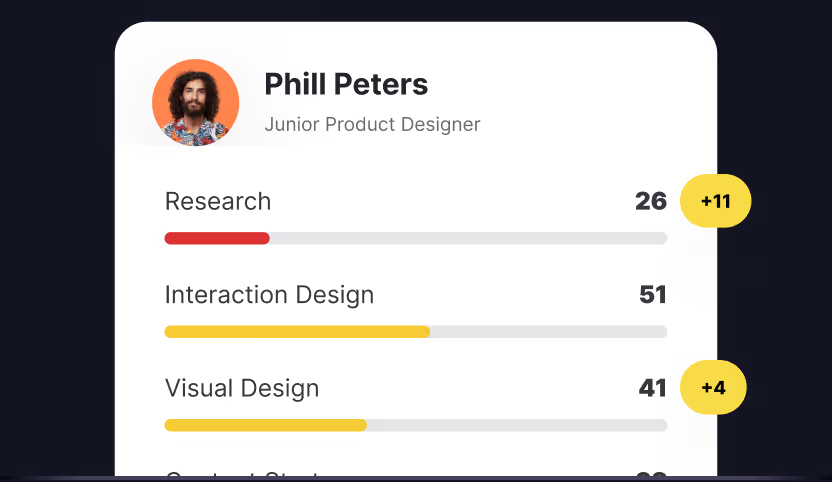
Design, and especially user experience design, is a field that is constantly evolving and changing. As a consequence, professionals working in this field need to continually update their knowledge and integrate new methodologies that are popping up into existence.
This can put designers who work full-time in a corporate environment in a difficult spot. Since they have less time to keep up with the industry, they might struggle to progress in their skills. It can pose a problem to managers, who are responsible for the results of a design team within a company.
As a manager, your responsibilities extend to monitoring your team, understanding their strengths and weaknesses, enhancing their skills, and delegating tasks effectively. If you weren’t a designer before you became a manager, you will likely need help to successfully perform these tasks.
When it comes to filling the gaps in the knowledge of your designers, enrolling in reputable design learning platforms becomes a practical solution. Today, we will present you a full comparison between Uxcel Teams and Coursera.
Uxcel Teams vs Coursera Overview
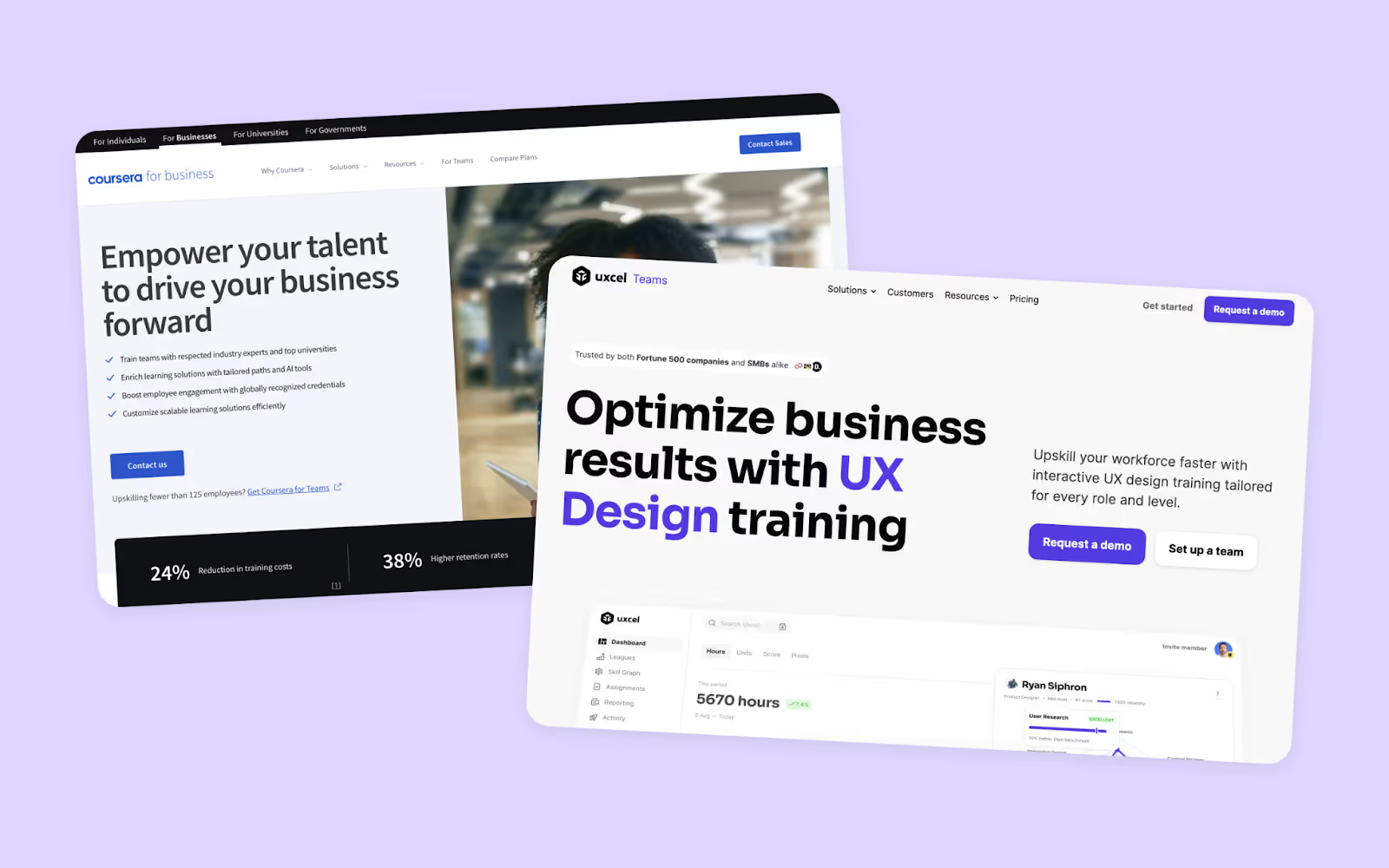
Coursera is one of the leading and most famous online learning platforms that partners with top universities and organizations. They offer a wide range of courses, specializations, and certificates. Since its inception in 2012, it has drawn many lecturers from renowned institutions like Stanford, Yale, and the University of Michigan, among others. Of course, there are also many self-made instructors with amazing courses who don’t have a strong university behind them, but that’s the beauty of this platform. Anyone can try to teach, but the students will be the judges of the material’s quality.
Apart from design courses, the platform features courses across various fields, including technology, business, data science, arts, and personal development.
Unlike many other similar platforms, Coursera emphasizes practical skills and offers hands-on projects, quizzes, and peer interactions to enhance the learning experience. With its user-friendly interface and mobile accessibility, Coursera makes it easy for anyone to learn at their own pace, whether they’re seeking to upskill, change careers, or pursue personal interests. However, Coursera is mostly focusing on individuals, despite having a Coursera for Businesses section. They have a selection of content recommended to businesses, but it is ultimately the same content primarily crafted for individuals.
In contrast, Uxcel Teams is specifically designed for managers responsible for design teams. It is founded by designers with rich corporate experience who understand the unique challenges faced by design departments. Uxcel Teams aims to resolve common issues encountered during corporate projects and provides a range of specialized design learning materials and unique advantages that you can’t find anywhere else, and all that for a competitive price!
Uxcel Teams Main Benefits
As a platform made by designers for designers, Uxcel Teams is dedicated to improving designers’ output, communication, and overall experience of a corporate design team and everyone who is dealing with it. There are lots of unique benefits of this specialized platform, but here we will talk only about the main ones:
- Skill Graph Showing Proficiency Levels for all Designers within the Team
- Gamified Learning Approach
- Personalized Recommendations and Efficient Educational Material Distribution
- Ability to Monitor Skill Development and Learning Pace Effectively
- Standardized Design Terminology for Better Communication between Departments
- Tools to Match Individual Designers with Suitable Projects
- Slack is Completely Integrated with Uxcel
Skill Graph Showing Proficiency Levels for all Designers within the Team
A standout feature of Uxcel Teams is its Skill Graph, which provides an accurate and detailed representation of each designer's skill set. You won’t be finding this feature at any other design learning platform. One of the most important tasks as a design team manager is to make sure your designers possess the necessary skills to deliver the results requested by the company. The Skill Graph enables you to gain a complete overview of your team’s capabilities. The best thing about it? The test which will evaluate the skills of each designer can be completed in less than 30 minutes!
This Skill Graph evaluates designers across several important design categories:
- Visual Design
- Interaction Design
- Research
- Content Strategy
- Leadership
- Product Thinking
Scores are represented on a scale from 1 to 100 and are visually depicted, which will allow you to easily compare individual designers in your team. Here is how it looks:
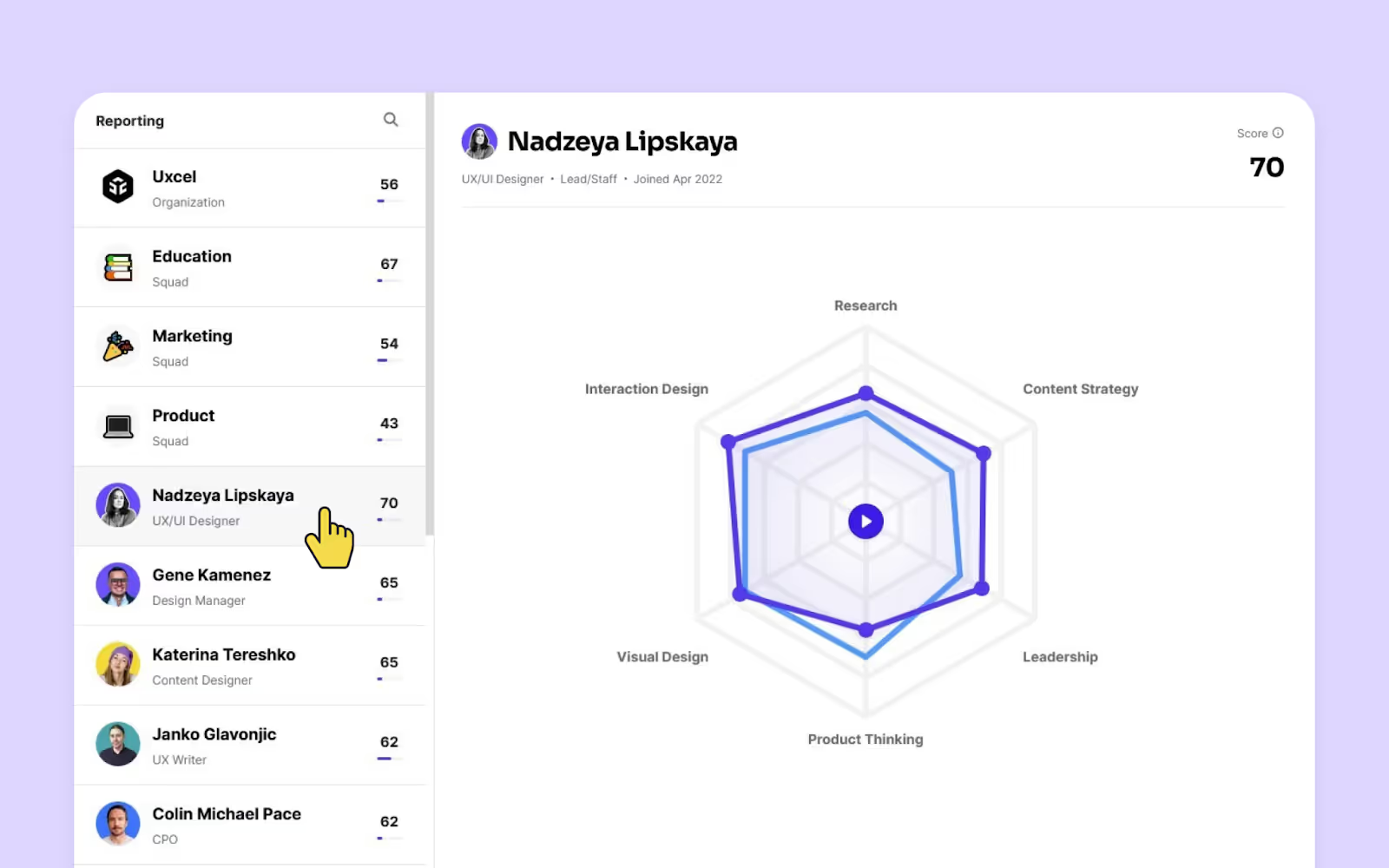
If your designers achieve scores similar to these, you can be very happy with their capabilities. Nadzeya excels in Visual Design and Interaction Design, along with strengths in Leadership and Content Strategy. Product Thinking and Research are a bit lower than the rest of the skills. If you want Nadzeya to work on them, you would be able to assign some custom learning content, but more on that later.
Maybe you noticed red exclamation marks next to some names within your team. If you click it, you will see this message:
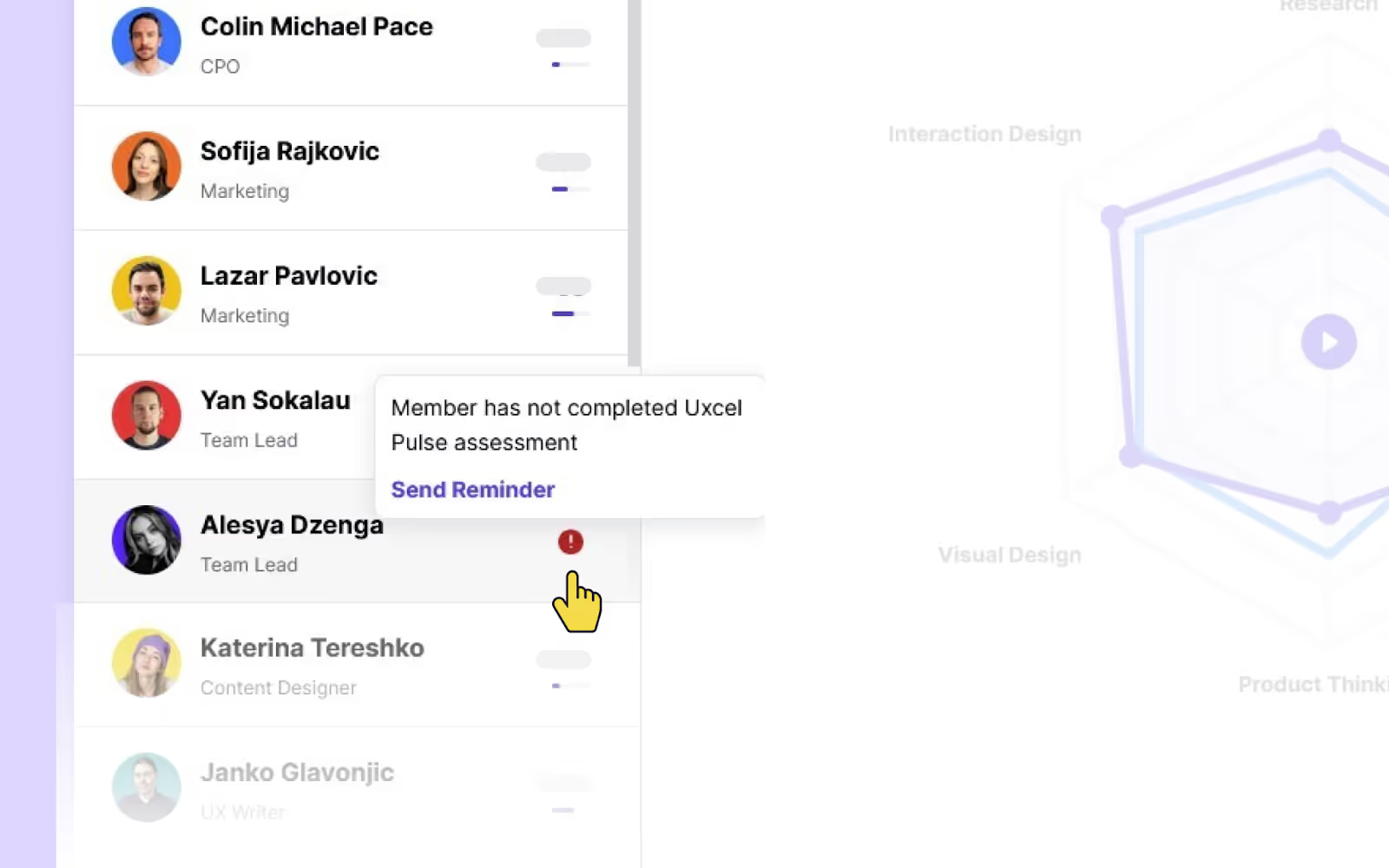
After you allocate the seats for your designers within Uxcel Teams, every team member is required to complete a Uxcel Pulse assessment. That is a straightforward test that takes under 30 minutes, and it is used to measure the skills of every individual designer and create an accurate Skill Graph. If someone forgets to complete the assessment, sending reminders is an easy process, and you can do it from here.
Gamified Learning Approach
While few platforms incorporate gamification into their learning processes, Uxcel Teams makes it a core experience. Most traditional learning platforms offer courses, tests, and other typical learning materials that resemble going to school or college. The founders of Uxcel understand that designers working full time for a company don’t have time to allocate for that. The designers behind Uxcel Teams were in those shoes themselves, so they embraced a different approach.
This platform makes content digestible and appealing to busy professionals. Short lessons, followed by assessments and interactive tests will allow designers to learn without putting much effort or allocating many hours weekly. The platform is mobile-optimized as well, which makes it even easier to use when you have a bit of spare time while waiting for feedback, or an email from your colleague, or simply commuting to work.
For example, this is one of the questions you will find in Uxcel Teams learning content:
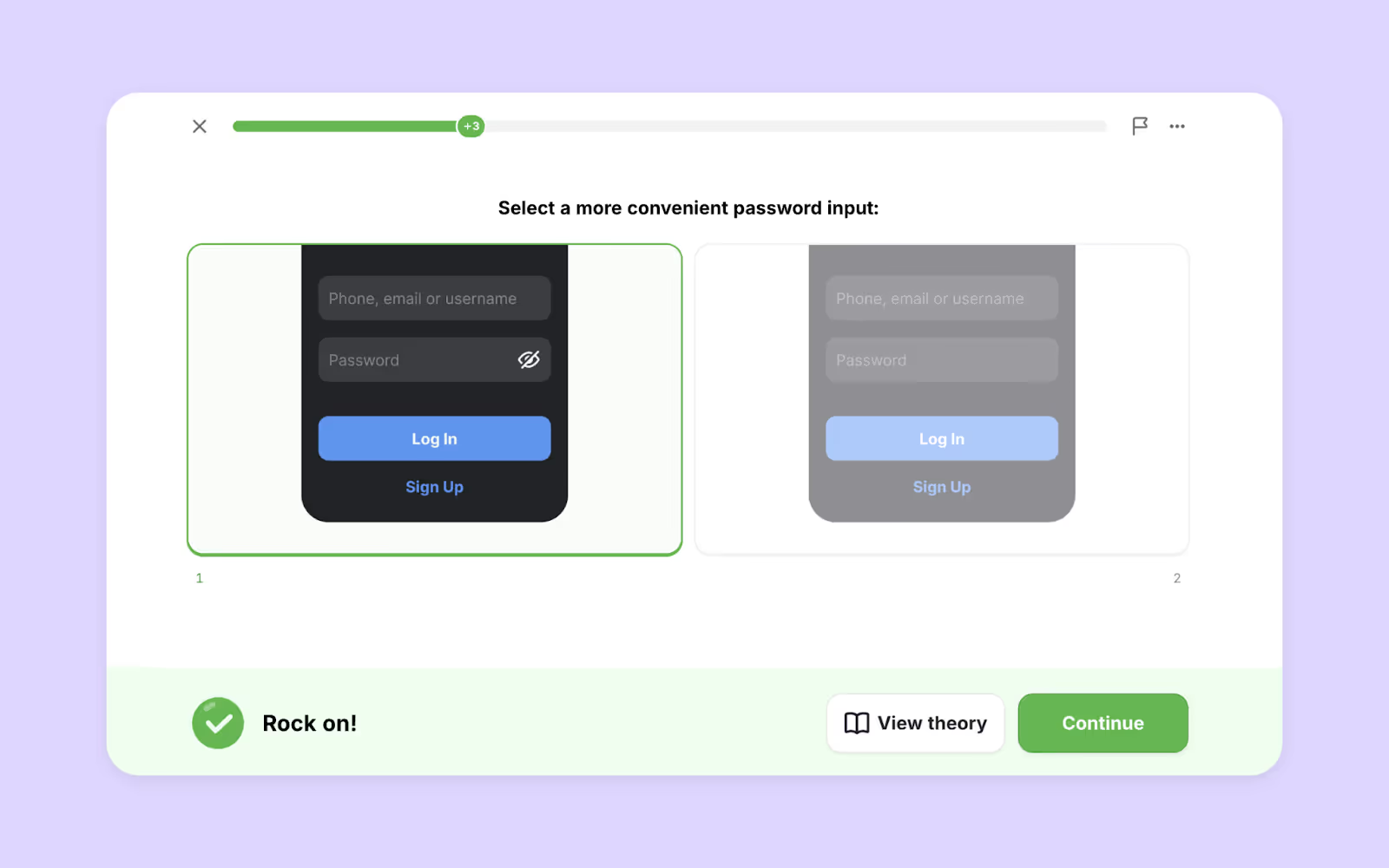
Personalized Recommendations and Efficient Educational Material Distribution
Now that you have evaluated your designers’ skills, it’s crucial to address their knowledge gaps. With Uxcel Teams, it is easy to find the right content for your designers and watch how their skill grows. On the other hand, this is an area where many other platforms fall short, including Coursera. Coursera is pretty standard when it comes to the courses it offers. The systematization of Coursera courses is by no means bad, and you can also use the search function to narrow down the results.
However, most of Coursera's solutions for a problem would be in the form of courses that last for many hours, in which it is not that easy to navigate to individual lessons and find the piece of information you need.
With Uxcel Teams, everything is about efficiency. As the manager, you want to delegate the work and learning materials as fast as possible, while designers want to complete the task you gave them as fast as possible as well.
You can assign learning materials in two ways. The first method involves using the “Reporting” option available in the main menu, on the left-hand side of the screen:
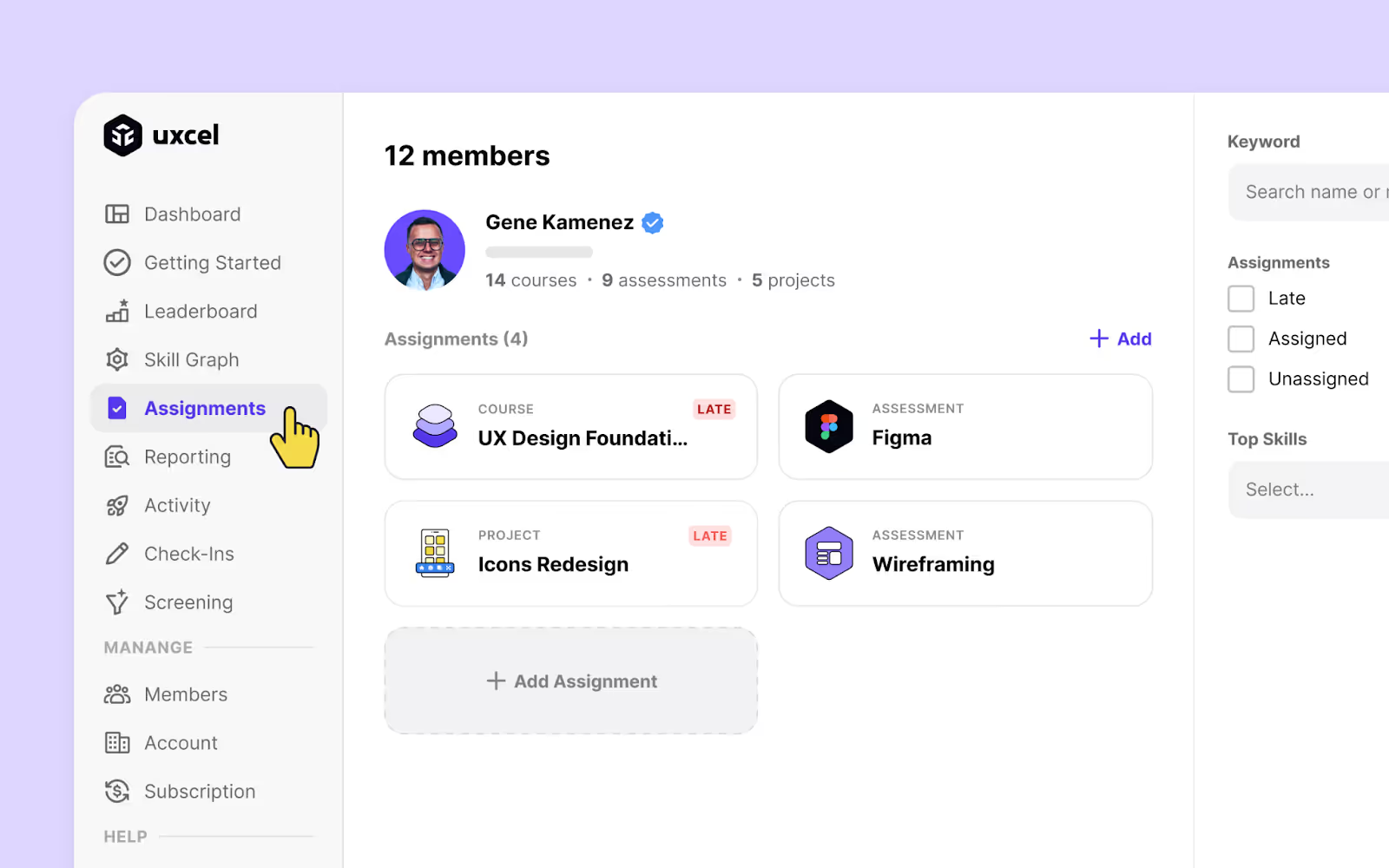
Here, you will be able to view all assignments, active and expired.

After that, you will see a new window, where you will be able to select the courses, assessments, project briefs and earning pixels:

Tracking assignments in detail is also possible. You can click on any assignment, in this case, “Earn 1000 PX”, and see each member’s progress throughout that assignment:
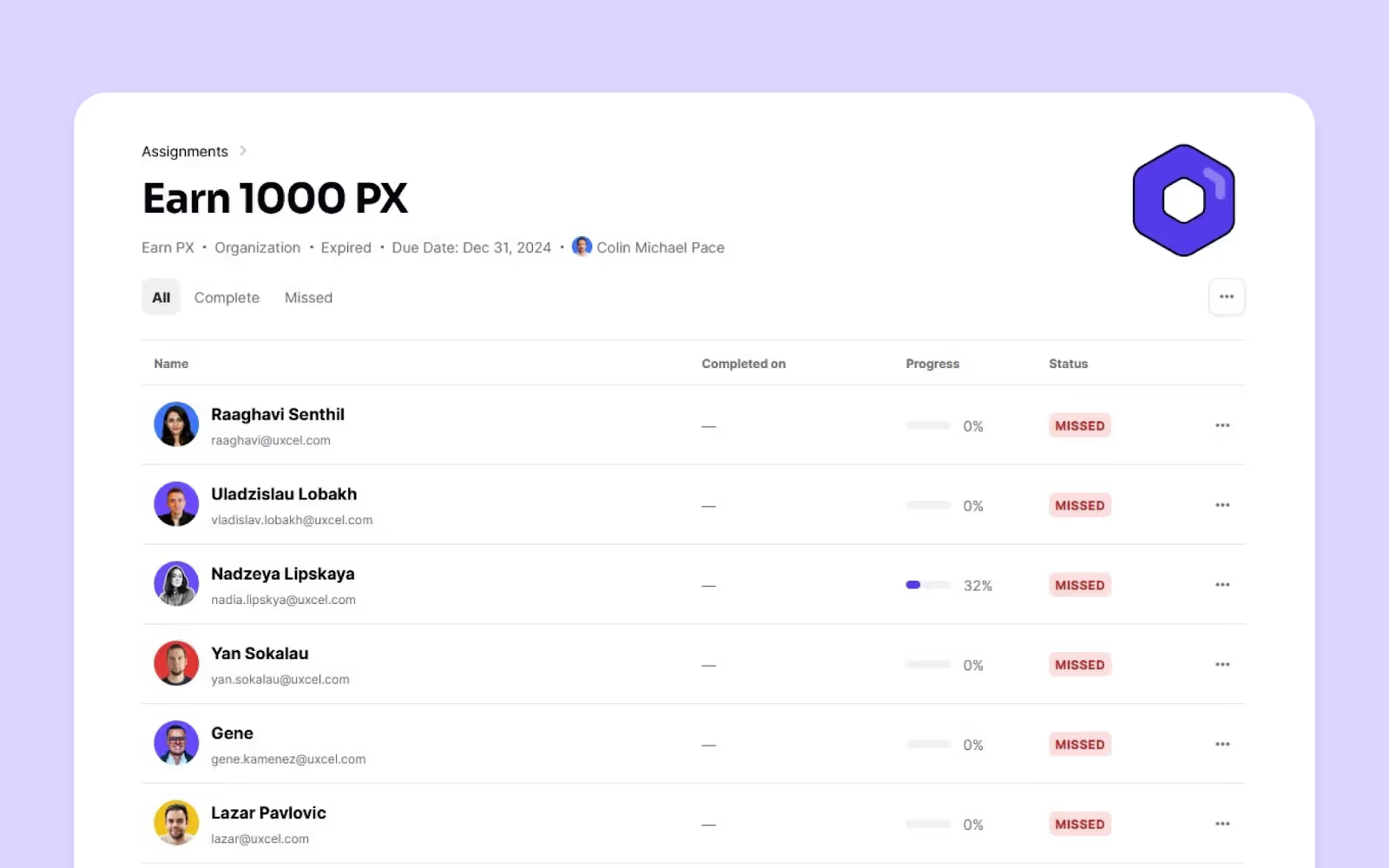
This beneft is very important, because it shows how your team handles assignments, and do they need any help with those.
In the window below, you will be able to assign earning pixels to an individual, a specific squad, or an entire organization:
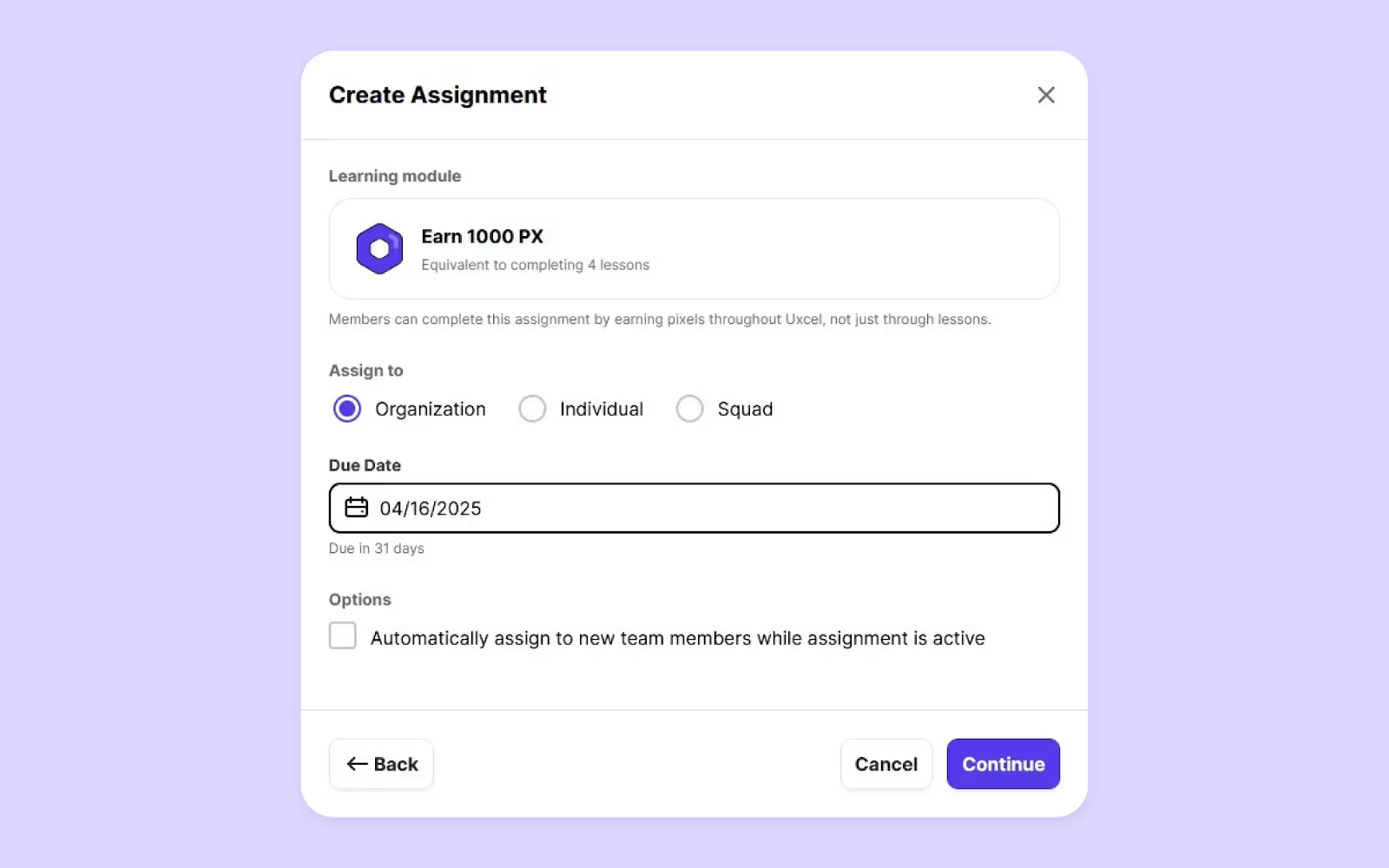
You can also choose a due date when the assignment should be completed, and automatically assign to new team members while the assignment is active.
Uxcel also provides another way of assigning task, you can do that directly from the team member menu.
First, click on the team member you want to assign content to, then click on the skill on the skill graph you want to develop. Let’s say you want to develop Visual Design. Click on it, and a new window will appear:
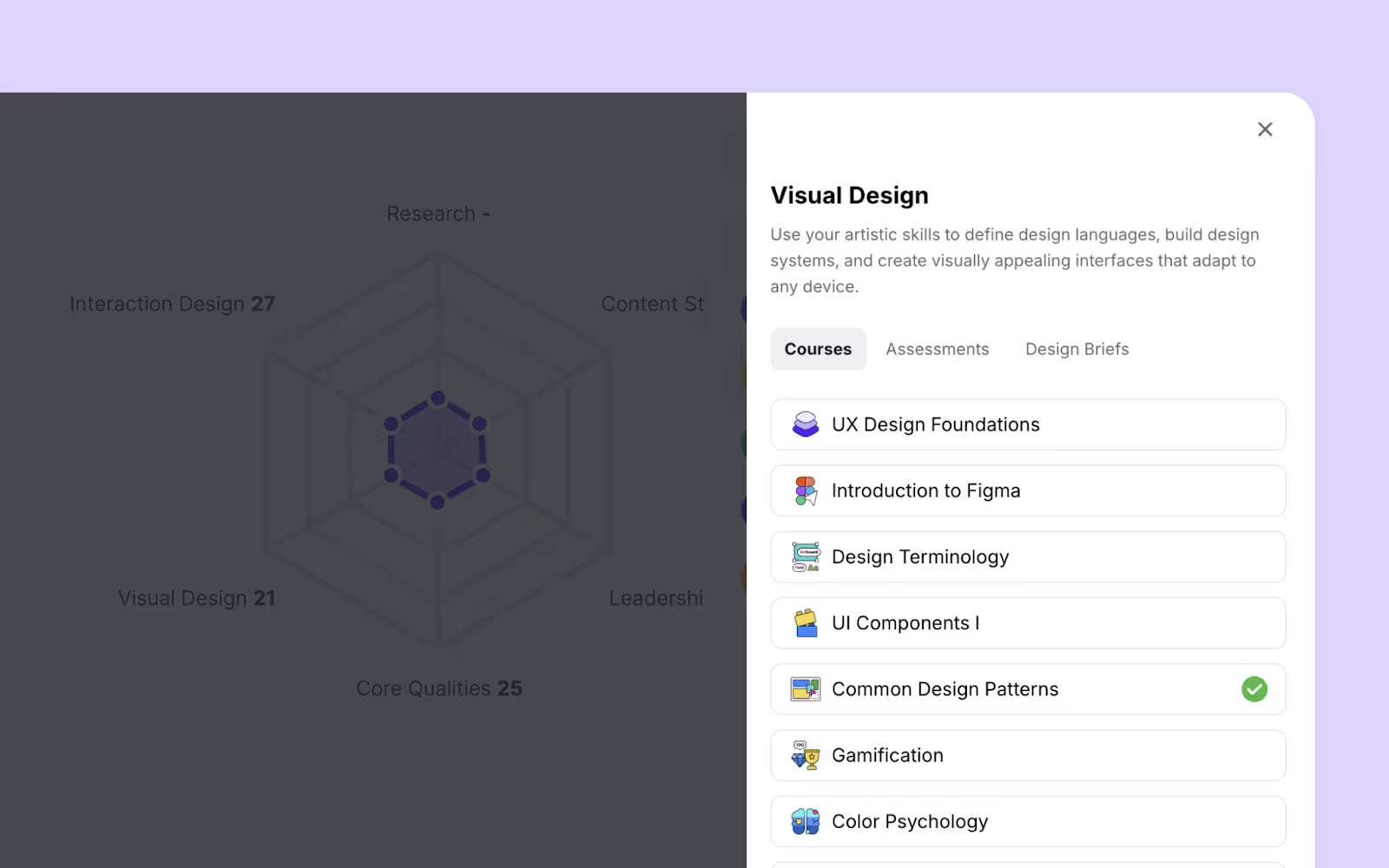
Here you can see Courses, Assessments, and Design Briefs related to Visual Design skill only, from which you can assign learning material to the member that will ultimately increase their Visual Design skill. This is great for seeing which learning material will affect the particular skill.
You can also create assignments directly from the specific course, assessment, project brief, or any other learning material that Uxcel supports:
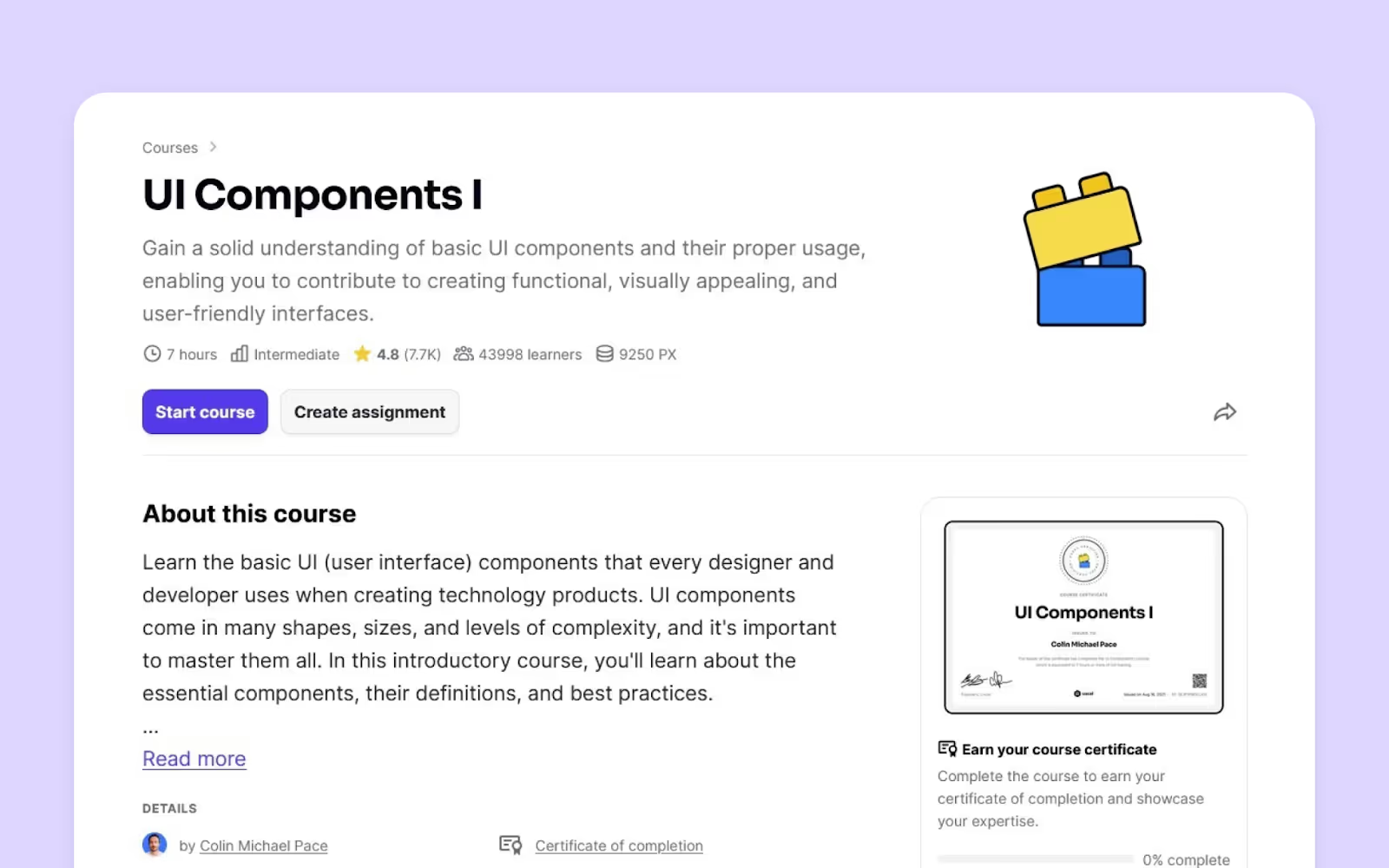
For example, assigning UI Components I course is easy. You will do it by clicking on the “Create assignment” button:

Ability to Monitor Skill Development and Learning Pace Effectively
When searching for a design learning platform, the ability to monitor your team’s progress is essential. Understanding how quickly they learn and how it impacts their design capabilities can significantly influence your department’s success.
Many platforms, including Coursera, provide only basic reporting. You might be able to see if a designer viewed a lesson, the time they spent, and whether it was completed, but that’s often everything that you can see. Also, this data can be manipulated, by faking engagement while doing something else. Even if the designer was learning and watching lessons, it is very hard to measure the impact of that type of content on their skills.
In contrast, Uxcel Teams not only issues certificates upon completion but also provides advanced methods for assessing designers' knowledge. After finishing a learning task, Uxcel Teams updates the Skill Graph to reflect how that task has impacted their skills. This quantifiable assessment offers a clear picture of their development.
To monitor an individual designer’s progress, navigate to their profile and click “Play” button in the Skill Graph, you will see how their skills have improved over time:

Below the Skill Graph, you can see the reliability of Nadzeya’s assessment, comparison to other Uxcel members with the same position, how much time they spent learning and how that compares to the previous period, the score and how many pixels they got:

Right below this, you will be able to see more stats regarding assignments and unit competitions. This will display all completed assignments and courses, giving you valuable insights into each designer’s knowledge. Here is what that advanced reporting looks like:
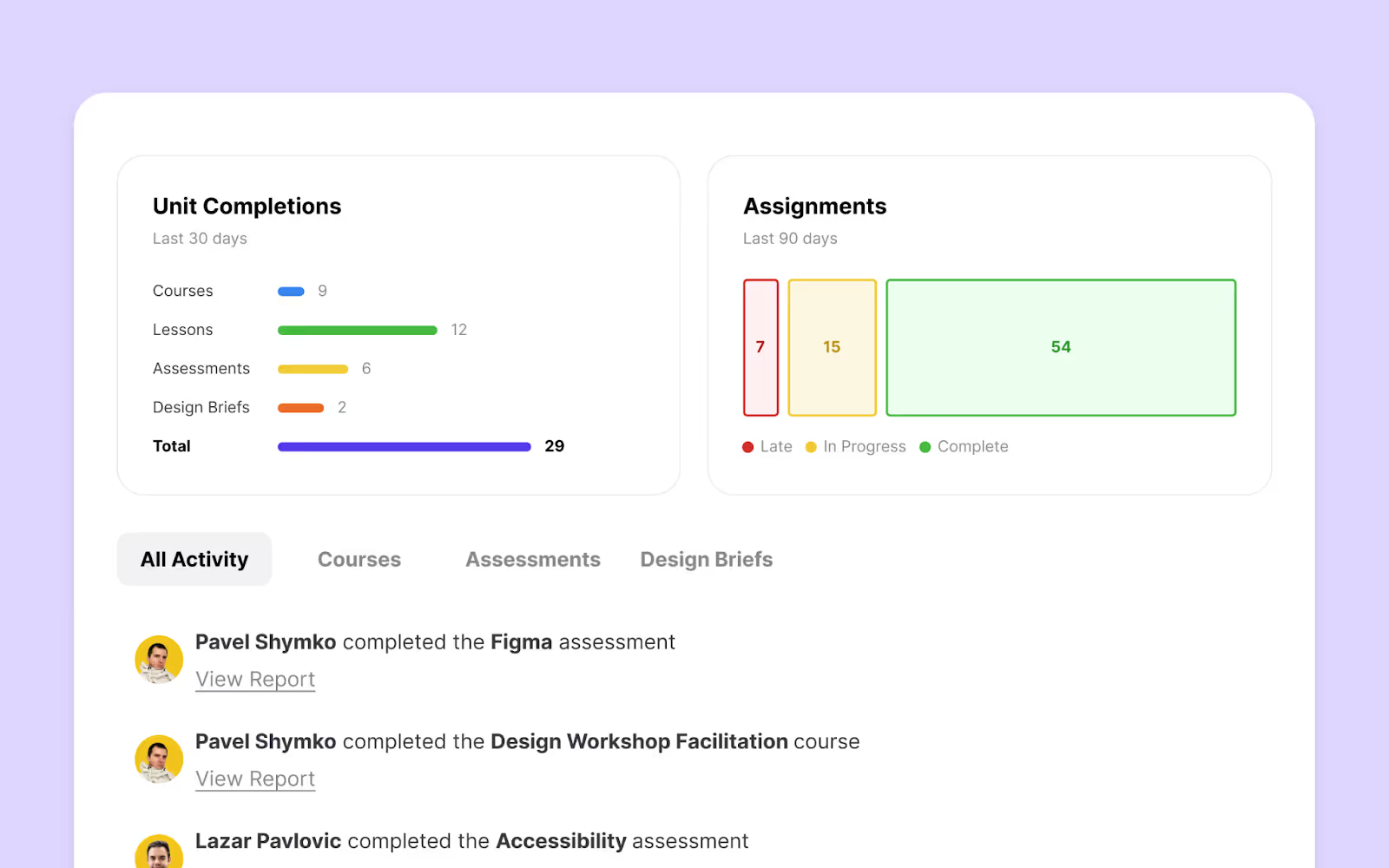
After getting this from Uxcel Teams, it is very difficult to come back to basic reporting. As a manager, you can compare designers with each other, see exactly what they learned and how that affected their skills, and delegate new learning material that will suit them.
Standardized Design Terminology for Better Communication between Departments
Effective communication within a company is crucial, especially concerning the specialized language used by designers, marketers, and other professionals. A lack of common terminology can hinder collaboration and efficiency.
The founders of Uxcel, drawing from their extensive corporate experience, recognized this challenge. Their platform includes a feature called “Squads” designed to group all the members of Uxcel Teams into departments:
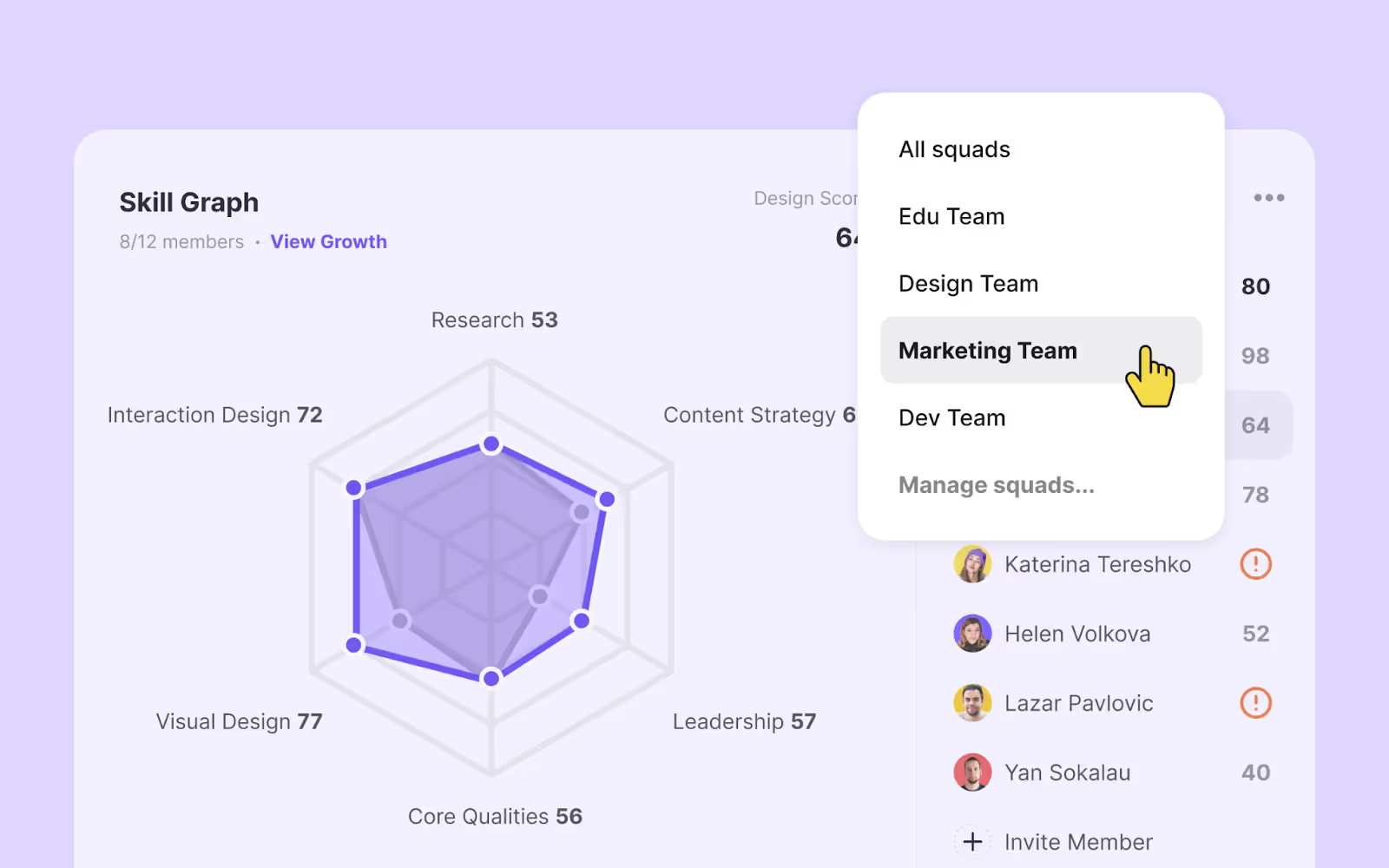
With Squads, you can assess all professionals connected through Uxcel, identifying areas where improvement is needed. This does not mean that your marketing team will be undergoing extensive design training, but rather allows you to assign relevant materials to the selected department to improve communication and efficiency.
For example, you might consider assigning the Uxcel Design Terminology course to everyone within the organization. Knowing the terminology and the basics of UX design will be helpful when allocating tasks to the design team, giving or receiving feedback, and so on.

Of course, Uxcel Teams also suggests other material related to that topic, which might also be helpful to professionals outside the design department. There is another thing that makes this benefit amazing for every company with defined departments. Every seat allocated to a professional who uses Uxcel Teams just for monitoring, and not for learning, is free!
Tools to Match Individual Designers with Suitable Projects
Finding the right designers for the right projects is one of the most critical responsibilities of any manager. Successfully matching tasks with the appropriate skill sets leads to satisfied clients, pleased supervisors, and a less stressed team.
Uxcel Teams makes this process smooth with its Top Skills feature. By selecting a specific skill from a dropdown menu, you can easily identify designers best suited for particular assignments. For instance, if Colin excels in Figma, he becomes the ideal candidate for tasks related to that tool.
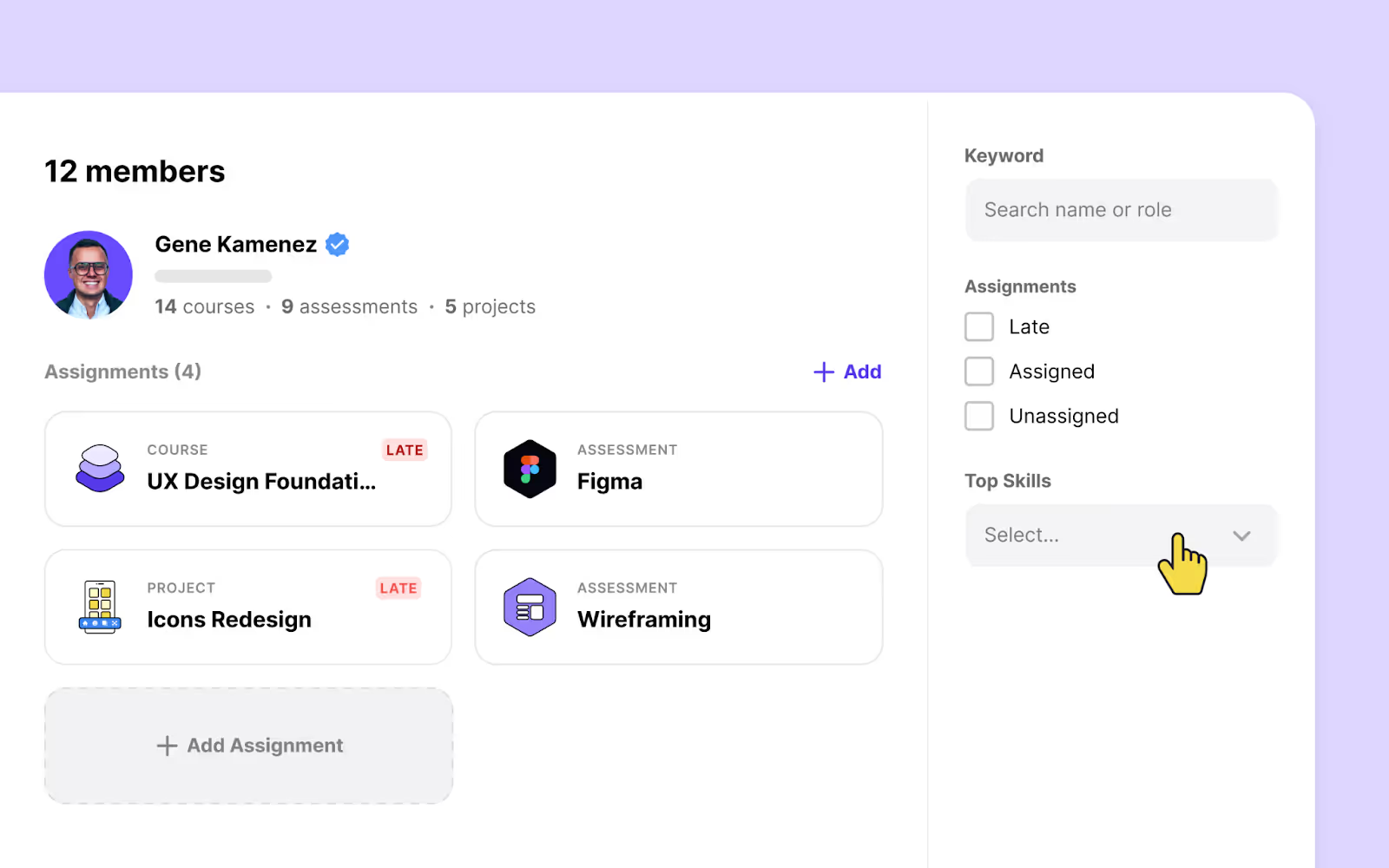
Below, you can see that Colin is great at Maze, too. Entering the keywords in the search bar will allow you to see other top skills from your team faster, you don’t need to scroll through each of their profiles.
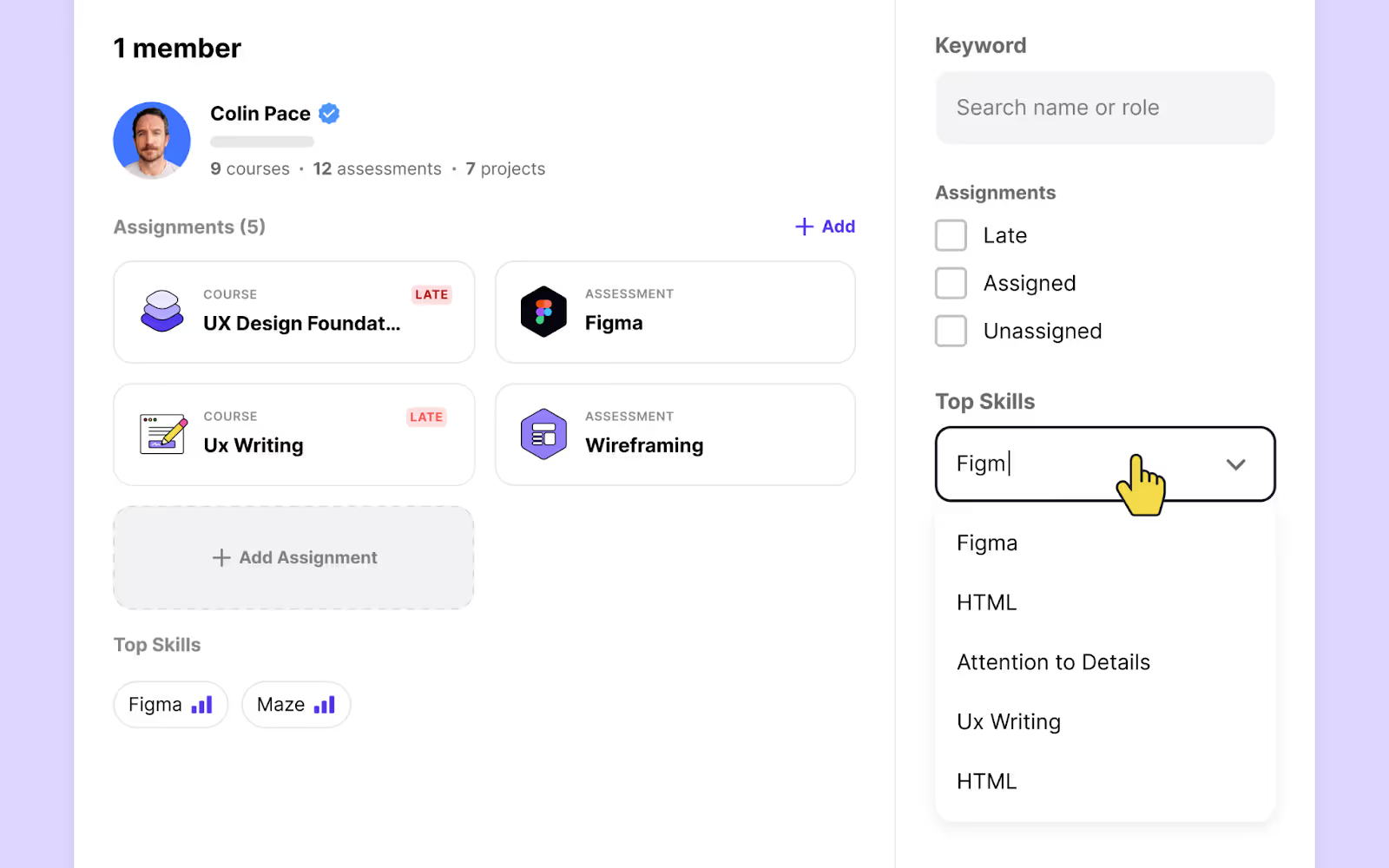
Use the Uxcel Slack App to Grow Design Team Skills Even Faster
Uxcel seamlessly integrates with Slack, one of the most widely used communication and operations tools in the workplace. Setting up the connection between Slack and Uxcel is simple, and the integration offers valuable features such as daily design tips, intelligent reminders, and a strong focus on team learning.
Coursera Main Benefits
Coursera was launched in 2012, and from the beginning, it showed the intention to partner with schools and universities. More than ten years later, their list is impressive and contains schools such as Columbia University, Duke University, and Carnegie Mellon University. This is the main benefit of this platform, but there are others:
- Partnerships with Top Educational Institutions
- Flexible Learning Options
- Customizable Learning Paths
- Large Catalog of Courses
Partnerships with Top Educational Institutions
Coursera never forgets to mention its partnership with well-known universities and schools. That has a role in their branding since it gives a sense of trust to potential customers. If Coursera is good enough for Duke, it is good enough for you, right?
Also, Coursera wanted to establish itself as an authority in online learning, across various fields. With experts who are professors at universities coming to Coursera to teach, they could try to market themselves as a professional learning platform that offers its students things they wouldn’t find anywhere else online, for a fraction of the price.
Flexible Learning Options
Coursera made an effort to allow the students to learn self-paced and also paid attention to the needs of teams, which is usable for companies as well.
If you are learning in a session-based course, you are a member of a group that is working on the same schedule, so you can discuss assignments, share ideas, or motivate each other. This is intended to be a randomized group made of individuals and strangers, but it doesn’t have to be like that. You can also use this feature for your whole design team, and delegate them the same course to learn with the same schedule.
Although it seems like a great idea, it is hard to expect that you could put the whole team on the same schedule and finish the work required at the same time. However, it is possible for an individual to transfer for a later session if they are falling behind, but that beats the point of session-based learning together in the first place.
Customizable Learning Paths
Coursera embraced AI-driven custom learning among the first platforms, and they are promising better results and productivity of the team with their system.
Basically, AI is able to customize content required for your designers faster, but that doesn’t mean it will be that precise and on-point. Coursera Coach offers AI-powered guidance, which should help you go through the learning material and offer real-time coaching, but you would still need different technical skills to fully harness the power of these tools.
You can use AI to give you recommendations for individual designers and custom tailor learning content for them, which resembles Skill Graph from Uxcel Teams, but this perk is murkier and it won’t result in an easily measured advancement in the skills of your designers.
Large Catalog of Courses
Coursera tried to solve one of the biggest issues with the material posted on the platform by partnering with more than 200 universities and companies, and the instructors from those companies and universities created thousands of courses on the platform.
Anyone can apply to be an instructor, but there is a catch: you should be affiliated with a company or school that is working with Coursera.
In theory, this should keep the low-quality courses from anonymous instructors off the site, but in reality, there are lots of courses on the platform that aren’t particularly great, or updated.
Also, if you want to get a real degree from Coursera, you will have to pay thousands of dollars, just like university students who graduated after learning on a similar plan. There are also way more courses for beginners compared to advanced classes, which is not suitable for companies.
Uxcel Teams vs Coursera Comparison Table
Uxcel Teams vs Coursera Verdict

Coursera for Businesses looks more modern than some of the similar platforms that offer the same perks to companies, but it is not easily digestible nor applicable to a design team working for a company full time.
AI learning is becoming a thing, but without clear guidance, technical knowledge, and quality input from the bots, you won’t save time as promised, but instead spend it learning the fundamentals of the new technology.
Although that will likely benefit your team and the company in the long run, it is distracting at first and makes it hard to assess all the pros and cons of the platform.
The price tag is also hefty, and the fact you should commit for a full year to get the best deal is not very budget-friendly. In the end, Coursera is a platform that isn’t specialized in design, which makes it potentially inferior to platforms such as Interaction Design Foundation, Nielsen Norman Institute, and Uxcel.
On the other hand, Uxcel Teams was created by designers for designers, and their intention was to tackle specific problems they faced while working for a big company. You won’t find the features Uxcel is offering on any other design learning platform, and the benefits of the platform are easily visible within a month of signing up.
Uxcel Teams is also more affordable at only $25 per month per seat. Another benefit of Uxcel Teams compared to every other platform is the fact you can allocate seats to your HR, Marketing, and other departments, and if they don’t use Uxcel Teams for learning, those seats are free! Uxcel founders know the importance of monitoring the progress of designers and connecting the departments well.
Despite Coursera being a well-known and reputable platform with some amazing courses that could certainly benefit your designers, when we measure the impact and how both platforms would fit your company, it is clear that Uxcel Teams is a better choice




